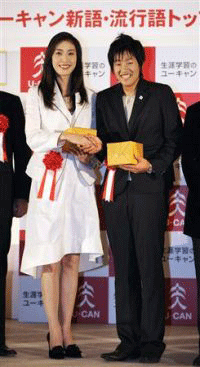 Actress Amami Yuki (left) accepts an award for helping to popularize “Ara-fo.”
Actress Amami Yuki (left) accepts an award for helping to popularize “Ara-fo.” by Alisa Freedman, Assistant Professor of Japanese Literature and Film
Editor’s Note: In 2009, Professor Freedman received a CSWS Faculty Research Grant of nearly $4,000 to support her research in Japan. On October 28, she will offer a CSWS Noon Talk in the Jane Grant Room, Hendricks Hall, to discuss her research.
Thanks to the help of a CSWS grant, I spent the summer in Tokyo, conducting research for my books on changing images of workingwomen on Japanese television, Modern Girls in Motion: Gender, Mobility, and Labor in Japan, and Tokyo in Transit: Japanese Culture on the Rails and Road. In general, my interdisciplinary work explores how the city shapes culture and psychology, giving rise to gender roles that characterize Japan. My research takes two forms. The first involves analyzing stories—those told in literature, television, journalism, cinema, and other popular media—that capture Japanese women’s experiences in a creative and thought-provoking way. The second entails wandering Tokyo to observe patterns of daily life and dominant trends and pondering the reasons behind them.
For example, an important current trend is the “eco boom,” “eco” for “ecology” and “boom” the Japanese term for fads. (Japanese catchphrases are often abbreviations formed from first syllables of words.) As in the United States, the Japanese government is rewarding consumers for buying energy-saving appliances and cars. Climbing Mount Fuji has become a top vacation choice. Non-smoking areas are increasing in Tokyo, as are rooftop gardens and other spots that add green to this city strikingly devoid of grass. Department stores are cutting back on the lavish paper packaging for which they have been known. There is a proliferation of urban guides by young artists, who, although compassionate, glamorize the growing problem of homelessness as ecological living. Another boom has been the continued application of key words to groups of women, thereby making their lifestyles easier to understand and less threatening and turning them into symbols of social progress and problems.
One key term that has caught my attention is “ara-fo,” or “around 40.” Voted the most important word coined in 2008, “ara fo” connotes women born between 1965 and 1974, who came of age in the Bubble Era and entered the workforce as the Equal Employment Opportunity Law (EEOL) was being implemented. (“Ara-fo” tied for top new word with “gû,” from the English “good,” slang used on television commercials by female comedian Edo Harumi, who keeps her date of birth secret.) Derived from the lesser-used fashion marketing term “ara sa,” or “around 30,” “ara-fo” has given rise to nicknames for women of different generations, including the “ara-fifu” (around 50) and “ara-kan” (around “kanreki” or the age of mandatory retirement at 60). None of these usually apply to men, who are classified more by their occupations than by their ages.
Because of legal, educational, and economic developments and thanks to activist movements, “ara fo,” in theory, have more choices in employment, marriage, and childbearing than women have historically enjoyed. Perceived as marking a break with women of the past, “ara-fo,” have been viewed as a measure of the advancement of gender equality and of personal happiness, political topics during a time of national concern over falling birthrates and an aging society in ways different than before. Family care issues pertaining to “ara-fo,” and working women in general, were prime issues in the August national election, in which the right-leaning Liberal Democratic Party (LDP), in power for more than 50 years, was defeated by the more centrist Democratic Party of Japan (DPJ, formed in 1998). “Ara-fo” have also been widely perceived as representing the difficulties of individual freedom and have been described as demanding and selfish in the spate of television programs, books, and the magazines for and about them.
 Actress Amami Yuki (left) accepts an award for helping to popularize “Ara-fo.”
Actress Amami Yuki (left) accepts an award for helping to popularize “Ara-fo.” The term “ara-fo” and the gender trends the word encapsulated were brought to national attention by the fictional television drama “Around Forty: Women Who Want It All” (Chumon no ooi onnatachi), which aired Friday nights at 10:00 from April to June 2008 and provided role models for this demographic. Arguably discussed more in the mass media than any other television series of 2008, this character-driven narrative follows a few important months in the lives of three friends as they interact with men, who also represent national issues and archetypes, and make decisions about their futures. Left open ended and not ending in the main characters’ happy marriages, “Around Forty” can be read as both a part of and a break in a history of prime-time television dramas developed since the late 1980s that use urban workingwomen to present serious social messages in a lighthearted way that most often perpetuate rather than subvert dominant state discourses and gender norms.
While the generation of 35- to 44-year-olds is diverse, the unmarried, highly educated, and upper middle-class members, many of whom work in professions that used to be dominated by men, have been discussed the most. The central of the three “Around Forty” protagonists is a poster woman for this group. On one hand, they have been blamed for not having babies. On the other hand, their work outside the home is being taken seriously in a country that still has fewer female corporate managers and politicians than other developed nations. They are a target consumer bracket and have been, in recent years, finally able to secure mortgages. Because marriage has been viewed in government and journalistic discourses as a means to paternity, late marriage has also become an issue of national concern.
 Actress Amami Yuki (left) accepts an award for helping to popularize “Ara-fo.”
Actress Amami Yuki (left) accepts an award for helping to popularize “Ara-fo.” A new term that represents 2009 is “konkatsu,” or activities (katsudo), in which men and women with similar interests can meet potential spouses. (“Kekkon” is the Japanese word for “marriage.”) “Konkatsu” occur on the growing variety of online dating sites and in person. I inadvertently stepped into a Friday night “konkatsu” aerobics class for professionals around age 40 at my Tokyo gym. (The inverse of “konkatsu” is “rikatsu,” a now popular slang for the divorce process.) Matchmaking activities have been a large part of Japanese culture, taking such forms as gatherings among friends (gokon) and arranged marriage meetings (omiai). Yet “konkatsu” makes dating more of a public issue. Used in conjunction with “ara-fo,” the term alludes to a growing recognition that both men and women have multiple life choices, while showing that continued importance of marriage in Japan, where the family forms the backbone of society and often the sole unit of care.
As I saw this summer, the discussions about “ara fo” and related terms reveal larger patterns in Japanese society and the important role gender plays in Japanese politics. New words are evidence that women are seeking happiness in more diverse roles. Women have always worked in Japan. Female corporate employees are a common sight on Tokyo trains. Fewer women wear uniforms that used to be required dress for secretaries, or “office ladies” (OL), to show their membership to the corporation and distinguish them from their colleagues working jobs believed to be less temporary. The custom of adopting high-pitched voices to be polite seems to have ended, and women speak in normal tones in business situations. (We were trained in my Japanese languages classes to have voice inflections of Mini Mouse.) Yet in popular culture and the national images the government promotes at home and abroad, women are still most often depicted in service roles. Hello Kitty, born in 1976 and thus an “ara-fo,” has been marketed wearing uniforms of various female service laborers, but she has never been seen as a professional, such as a doctor, politician, or professor. Japanese booms burst fast and keywords fall out of use. Yet they have a lasting influence in changing public attitudes.

